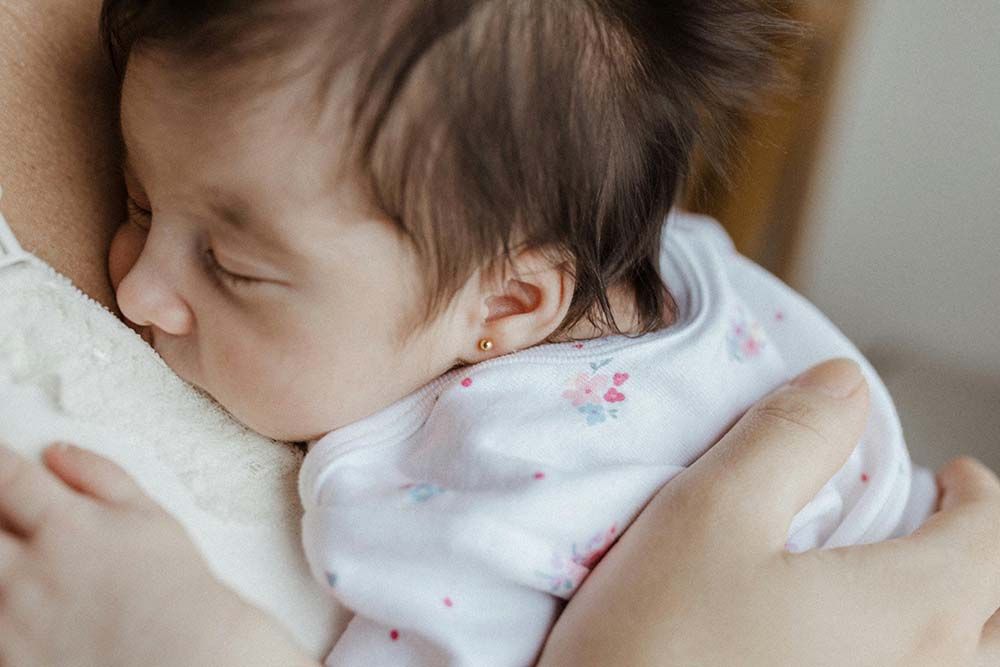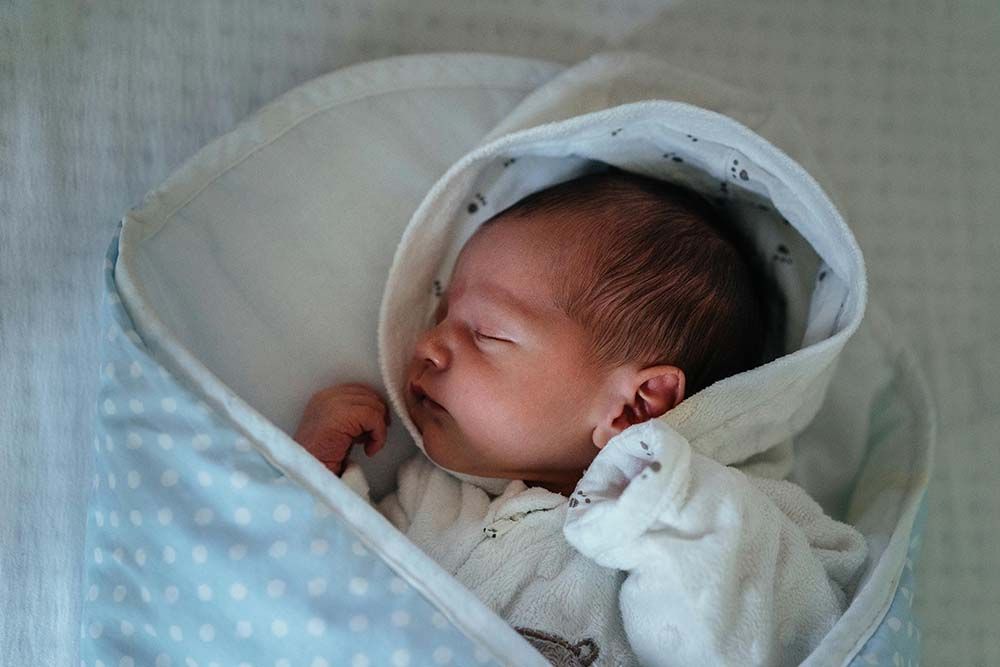

According to our research, over 85% new parents have problems with their baby’s sleep. To solve it, the key lies in master in the wake windows of a baby. However, with the rapid development of newborns, their wake windows have changed accordingly. Want to figure out your baby’s sleep issue? Welcome to read this post, which aims to show you baby’s wake windows by age, allowing parents to have a better understanding their babies at different stage.
Make wake windows easily
To be honest, it is not an easy task to track and adjust wake windows manually. If you are finding a parenting app to make it simple, it is strongly recommended to use Moonycare Track App, its Goldilocks function is specially designed for recording sleep time. Once it knows the last time when your baby wake up, it will accurately predict the next wake time for your baby. Use it to unlock more rights.
IN THIS ARTICLE
When do Babies’ Wake Windows Start and End?
What to do During Wake Windows?
When Need to Adjust Babies’ Wake Windows?
What are the Signs That the Baby is Tired?
How to Prolong Wake Windows as Your Baby Grows?
How Could I Know Whether the Wake Windows are Suitable?
How Can Wake Windows Help Babies’ Sleep?
What is the Meaning of Wake Windows?
The wake window refers to the period of time between the end of one sleep and the beginning of the next sleep. During this period, babies are awake and take part in daily activities. The length of this period has an important impact on children's sleep quality and emotional state. The concept of the wake window is also related to the body's biological clock and circadian rhythm, which reflects the body's wakefulness and activity level at different times of the day.
When do Babies’ Wake Windows Start and End?
Knowing when your baby's wake window starts and ends can help you plan your baby's daily routine, improve their sleep quality, reduce crying and overtiredness. Actually, the beginning and end of your baby's wake window changes as they grow, and the length of each baby's wake window may be different. However, there are some methods to help you identify it.
How to identify the beginning:
- Spontaneous waking: When babies wake up naturally, they usually appear happy and awake. If your baby becomes fussy or cries soon after waking up, it may be because they are not fully awake or have exceeded their optimal wake window.
- Activity level: After waking up, they appear active and may laugh, babble, or look around. They will show interest in their surroundings and be willing to interact with people.
- Emotional state: Upon waking up, they are emotionally stable and have no obvious discomfort or irritability. They may seek interaction with their parents or caregivers, such as reaching for a hug or playing with toys.
How to identify the the end:
- Signs of sleepiness: They will show behaviors that indicate sleepiness, such as rubbing their eyes or yawning
- Emotional changes: Babies may start crying or throwing tantrums, especially when they are overtired. They may also become impatient and unwilling to participate in activities or play.
- Body language: The baby may seek comfort positions, such as curling up or leaning against their parents or caregivers, and then beginning to close or half-close their eyes in an attempt to fall asleep.
Wake Windows by Age
The length of the wake window is especially important for infants and young children, because their sleep patterns are not yet fully formed and they need to adjust their wake windows to help them establish healthy sleep habits. A wake window that is too long or too short can have adverse effects on a baby's health. For example, a wake window that is too long can lead to fatigue accumulation and affect the quality of sleep at night; while a wake window that is too short can disrupt the normal biological clock, leading to excessive daytime sleepiness or difficulty falling asleep at night.
Therefore, understanding and grasping the baby's wake window is very important for promoting the baby's healthy growth, good sleep quality, and emotional regulation. Babies of every age have an ideal "wake window". Next, we will show you the scientific wake windows by age:
0-2 months: 30 to 90 minutes
2-4 months: 1 to 1.5 hours
4-6 months: 1.5 to 2.5 hours
7-9 months: 2 to 3.5 hours
What to do During Wake Windows?
When your baby is awake, it is recommended to do the following things. For example:
- Feeding: Feed according to the baby's dietary needs.
- Changing diapers: Check and change diapers before and after each feeding to avoid discomfort caused by wet diapers.
- Skin-to-skin contact: Skin-to-skin contact, such as hugging and caressing, helps to strengthen the parent-child relationship.
- Play: Provide suitable toys, such as black and white contrasting picture cards, rattles, and soft cloth books to encourage the baby to explore and learn. You can use colorful and sounding toys to attract the baby's attention.
- Parent-child interaction: Conduct more parent-child interactions, such as face-to-face games, simple nursery rhymes and stories. You can enhance the parent-child relationship by imitating the baby's voice and expressions. You can try to talk to the baby in a soft voice to help the baby build language perception ability.
- Outdoor activities: Take the baby for a walk outdoors to feel the fresh air and sunshine. You can choose a place with more interactive elements, such as a children's playground, so that the baby has the opportunity to interact with other children.
- Developing skills: Encourage the baby to practice turning over, crawling and sitting. You can place some toys on the soft cushion to guide the baby to grab, thereby promoting the development of body coordination and muscle strength.
- Independent Exploration: Provide a safe environment for your baby to explore and crawl freely.
You can choose 2 or 3 activities according to your baby’s age and condition.
When Need to Adjust Babies’ Wake Windows?
Age is not the only and accurate standard for parents to adjust their baby’s wake windows. On the contrary, there is no rules that require parents must make adjustments at certain time. That is to say, age is just one of major factors for parents’ reference to when to make changes. Except for remembering the significant wake windows by age, you can also take actions if you have observed the following behaviors from you baby.
- Fight nap or nighttime sleep when it’s your planed time to sleep
- Take a short nap or completely skip the nap
- Seem to be not tired when get the baby to sleep
- Hard to fall asleep at night, or frequently wake up at night
- Notice the sleepy cues in your baby when it is not sleep time
- Encounter developmental milestones lead to sleep regressions, like teething or learning new skills
- Get some illness issue
- Have some unexpected events, like travel or changes in the environment, which may disturb your baby’s sleep pattern
What are the Signs That the Baby is Tired?
Signs that your baby is tired usually show up in some physical and emotional changes. Babies of different ages may show different signs of tiredness, but here are some common signs:
1. Eyes
Rubbing their eyes: Your baby may rub their eyes with their hands, which may be a sign of sleepiness.
Drooping eyelids: Your eyelids may become heavy and your baby's eyes may be a little closed.
Blurred eyes or difficulty focusing: Your baby may look glazed or have trouble focusing.
2. Body language
Yawning: This is a classic sign that your baby is feeling sleepy.
Frowning or tense expression: Your baby may appear restless and have a tense or unhappy expression.
Shaking or swaying the body: Some babies will shake their heads or turn their bodies to show that they are uncomfortable or tired.
Drooping head: Your baby may look down, have heavy eyelids, or look down completely.
3. Emotional changes
Becoming irritable or agitated: Your baby may be more irritable than usual and cry and get restless.
Showing irritable emotions: The baby may no longer be interested in activities that he usually likes, and may cry easily or show impatience with the parents' comfort.
Refusing to interact: The baby may be unwilling to interact with others and lose interest in toys and games. At the same time, he loses interest in the surrounding environment, cannot concentrate, and may begin to shift his eyes or his eyes become dull.
4. Behavioral changes
Sucking fingers or licking lips: Some babies will comfort themselves by sucking fingers, licking lips, etc. This is a way of self-soothing when they feel sleepy.
Movements become slow or uncoordinated: The baby's response becomes sluggish, and he may become less active or lose coordination.
Prefer a quiet environment: The baby may suddenly become quieter, look for a comfortable position, or show the need to stay quietly.
Want to be held or patted on the back gently: Some babies may want to be held by their parents when they are tired, or relax themselves by patting their backs or stroking them gently.
How to Prolong Wake Windows as Your Baby Grows?
Generally speaking, as a baby grows, the wake window will be prolonged accordingly. To help babies better adapt to longer wake window, parents can follow the below ways and suggestions to develop better sleep patterns. One needs keep in mind is that it is a gradual process. Don’t let your baby get too tired, otherwise, it will backfire and affect sleep quality.
1. Gradually extend the wake-up window
To avoid excessive fatigue and difficulty sleeping, it is best to extend the baby's wake window gradually. You can try to extend 10-15 minutes each time and then observe your baby’s performance to see whether there are mood swings, crying, or obvious signs of fatigue. If the baby adapts well, you can continue to extend it. But if the baby becomes particularly irritable or has difficulty falling asleep, you can temporarily shorten the wake window.
2. Increase the baby's activity level
The baby's activity level is also helpful to this process, because increasing activities can help the baby better consume energy and extend the awake time. You can:
Increase interaction time: such as singing, talking, and playing interactive games with the baby (such as grabbing toys, crawling, etc.) to help the baby stay energetic and alert.
Explore new environments: Take your baby out for a walk, change positions in the room, etc. New visual and environmental stimulation can help your baby stay awake longer.
Increase large muscle activities: If your baby is already able to crawl, sit, and stand, you can provide appropriate space for your baby to do more physical exercises (such as crawling, standing, grabbing, etc.), which will help your baby consume energy and help prolong the wake window.
3. Reasonably arrange bedtime activities
Make sure your baby has enough interaction and activities during wakefulness, but avoid overly exciting or overly stimulating activities before bedtime. It is more recommended to choose gentle activities, such as storytelling, singing, bathing, etc. When your baby is about to sleep, reduce environmental stimulation to make your baby feel comfortable and relaxed. You can dim the lights, reduce noise, or create a quiet and warm environment after your baby wakes up.
4. Adjust the schedule based on your baby’s biological clock
Babies usually have their own biological clocks, and they may be particularly sleepy or energetic during certain periods of time. Understanding your baby’s biological rhythms can help you extend your wake window at the right time. Each baby has a different routine. By observing your baby’s sleepiness signals, you can understand their biological clocks and adjust their wake-up time appropriately. At the same time, be careful to avoid overtiredness when extending the wake window. Overtired babies tend to become more irritable and even have difficulty falling asleep. Therefore, it is important to ensure that your baby can fall asleep smoothly after extended wake time.
5. Establish a regular schedule
A regular schedule helps your baby form his biological clock and reduce his reaction to sudden changes. Establishing a fixed feeding, activity and sleep time can help your baby adapt to longer wake-up times.
6. Avoid too long naps
Babies who take too long naps may have a problem with their sleep quality at night. Make sure your baby's nap is moderate, usually less than 2 hours. And don’t make the nap too close to sleep night at night, which can also make babies difficult to fall asleep at night, thereby causing a vicious circle for the new day.
7. Observe and record
Use a diary or application like Moonycare app to record your baby's activities and sleep time, and observe their sleepy signals and mood changes. Every baby is unique, and parents need to be flexible to their baby's specific needs, adjust the wake window appropriately when necessary, and observe their baby's reaction simultaneously.
How Could I Know Whether the Wake Windows are Suitable?
1. Observe the baby's emotions and behaviors
If the baby is emotionally stable after waking up, without frequent irritability, crying or mood swings. In a good mental state during the day, interested in participating in various activities, and even able to focus on toys or activities for a period of time, it suggests that the wake window is appropriate.
2. Pay attention to the baby's sleepiness signals
If the baby shows sleepiness signals within the expected time and the frequency is moderate, it may mean that the wake window is set correctly
3. Observe the baby's sleep quality
The baby can fall asleep easily in a short time and does not need long-term comfort. The nap time is moderate, and the baby can sleep continuously at night, wake up less or fall asleep quickly after waking up. All these indicate that the baby's sleep quality is good and the wake window may be appropriate.
On the contrary, it means that the baby's wake window is not appropriate and needs to be adjusted gradually.
How Can Wake Windows Help Babies’ Sleep?
The wake window plays an important role in baby’s sleep. With a proper arrangement, you may get the following effects for your babies:
- Avoid excessive fatigue
- Help establish a regular sleep pattern
- Improve the efficiency of falling asleep
- Avoid waking up at night
- Promote the growth and development of the baby
- Help the baby adapt to the environment
Notes on Baby's Safe Sleep
Except for obeying wake windows by age, it is also important for parents to pay attention to baby’s sleep safety, ensuring that the baby's sleeping environment is safe and comfortable . Here are some key notes on baby's safe sleep:
1. Put the baby in a safe sleeping environment
Independent crib: The baby should sleep in his own crib, cradle or dedicated baby sleeping bag. Avoid letting the baby sleep in the same bed with the parents, because sleeping with parents increases the risk of suffocation, being crushed or falling.
Flat and firm mattress: Make sure the mattress is flat and firm, and avoid using too soft mattresses, pillows, plush toys, etc., which may cause the baby's airway to be blocked.
2. Follow the "back sleeping" principle
Babies should always sleep on their backs: Letting your baby sleep in a supine position (i.e., back sleeping) is the most effective way to reduce the risk of sudden infant death syndrome (SIDS). Even if the baby learns to roll over, parents should insist on putting the baby in a back sleeping position.
Avoid stomach sleeping and side sleeping: Stomach sleeping or side sleeping increases the risk of SIDS because the baby's face is easily exposed to the soft surface of the bed, leading to suffocation. Side sleeping may cause the baby to roll over to the abdomen, which also poses a risk of suffocation.
3. Maintain a suitable sleeping temperature
Avoid overheating: Make sure the baby's sleeping environment is at a suitable temperature. The baby's sleeping environment temperature should be between 16-20°C. Avoid using too thick quilts, blankets, or dressing the baby too much to prevent the baby from overheating.
Dress appropriately: Dress the baby in a suitable sleeping bag or pajamas, and do not cover the baby with too many quilts. Using a baby sleeping bag (sleeveless, fitted) is a good choice to help the baby maintain a comfortable body temperature.
4. Avoid clutter on the bed
No toys or pillows: Do not place any soft items such as stuffed toys, pillows, thick quilts, etc. in the baby's sleeping area, which may increase the risk of suffocation. Especially for newborns and young babies, only clean sheets and suitable mattresses should be placed on the bed.
Avoid loose or wavy sheets: Make sure the sheets are flat and avoid loose quilts or sheets that may cause the baby's face to be covered.
5. Use a suitable crib
No gap design: When choosing a crib, make sure the gap between the rails of the bed does not exceed 2.5 cm to avoid the baby's hands or feet being stuck.
Secure the mattress: Make sure the mattress is placed firmly and fits the crib. The mattress should fill the bottom of the bed to prevent the baby from being trapped between the bed and the mattress.
6. Check the baby's sleeping environment regularly
Smoke-free environment: The baby's sleeping environment should be kept smoke-free, whether it is indoors or when the parents smoke themselves. Studies have shown that exposure to secondhand smoke is a known risk factor for sudden infant death syndrome (SIDS).
Check the safety of the sleeping environment: Check the safety of the baby's sleeping environment regularly to ensure that there are no items on the bed that may cause potential dangers.
Check the baby's sleeping position: Make sure the baby always sleeps on his back. If the baby rolls over to his stomach, you can gently turn him back to his back.
Use baby monitoring equipment: If necessary, you can use a baby monitor to keep monitoring the baby's sleep, especially for newborns or babies who sleep farther away. In this way, parents can know the baby's condition in real time and take timely measures.
Frequently Asked Questions on Wake Windows by Age
1. Do wake windows include feeding?
Yes, feeding is usually included in the baby's wake window. Reasonable arrangement of feeding time and wake-up time can ensure that the baby can get enough nutrition and avoid fatigue caused by too long wake windows. Appropriate wake-up activities and small rest time after feeding can help the baby establish a good sleep pattern and healthy work and rest habits.
2. Why is the first wake window the longest?
The baby's first wake window (i.e. the first awake time after waking up in the morning) is usually the longest. This is because the baby's body and brain have rested after a night's sleep, and the baby is relatively energetic. In addition, the environment is relatively quiet and less stimulating in the morning, so babies usually don't feel overly tired. As babies grow older, their biological clocks gradually establish, and their wake window time will gradually shorten, more in line with the changes in circadian rhythms. Therefore, parents need to flexibly adjust the length of the wake-up window when taking care of their babies to ensure that the baby can enjoy enough awake and active time while avoiding excessive fatigue, and help the baby establish healthy work and rest habits.
3. Does a longer nap mean a longer wake window?
The length of the nap does not directly determine the length of the wake window. The wake window of a baby is mainly determined by his energy consumption, activity level, age and sleep needs. Reasonable arrangement of nap and awake time, avoiding naps that are too long or too short, can help babies better maintain emotional stability and healthy work and rest patterns. When adjusting the nap time, parents need to flexibly adjust it according to the actual needs of the baby to ensure that the baby can get enough rest without affecting the quality of sleep at night due to a too long nap.
























